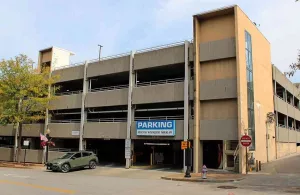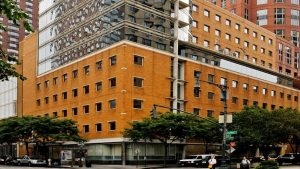Daytona Beach issues emergency demolition order for historic hotel
Published by John on
The Lyndhurst Hotel has stood for 121 years in downtown Daytona Beach. But years of decay have left the structure in such bad shape that the city has condemned the property located near the northwest corner of Beach Street and Mary McLeod Bethune Boulevard. In the early 1900s, the Lyndhurst Hotel was quite the posh riverfront getaway.
The three-story frame building had the look of a quaint country retreat with rocking chairs on the large wooden porch and plenty of palm trees, palmetto bushes and other lush greenery out front. In 1913, one of the hotel’s wealthy guests who had played shuffleboard on a cruise ship made the Lyndhurst the site of the first shuffleboard game played on land in the United States.
An advertisement for the hotel located just west of what is now Beach Street boasted that the establishment had “steam heat, electric lights, bath, Northern cooking, white help, hot and cold running water in all bedrooms.”
Now, more than 120 years after the hotel welcomed its first tourists, it has suffered a tragic fall from grace. Just after the sun rose Friday morning, demolition began on the badly dilapidated building on the eastern tip of Mary McLeod Bethune Boulevard that had been vacant for months.
A little over a week ago, the city’s top building official issued an emergency condemnation order. By the end of this week, every piece of the historic building will have been toppled and hauled off.
“The building official determined it was in imminent danger of collapse due to its eroded structural support and could be close to a catastrophic failure,” city officials posted on their Facebook page Feb. 22. “There are no occupants inside and it will be demolished as soon as possible.”
A representative of the company that owns the hotel, Regina Real Estate LLC, said a demolition order was issued last year. He said the property owner has been working on a plan to resuscitate the wooden structure built in 1898, and he didn’t seem to think demolition was imminent. The representative said he didn’t want to comment further or be name
The city’s notice of condemnation and demolition order posted on the front of the hotel building says a Ronald Johnson in Daytona Beach is affiliated with the real estate company. The mortgagee is listed as Richard Postlewait of Ormond Beach as well as Plantation Acres LLC and its registered agent, Douglas Dasilva of Las Vegas. Johnson, Postlewait and Dasilva could not be reached for comment.
A notice attached to the hotel’s weathered exterior siding said those responsible for the building could have pursued an appeal before the city’s Board of Building Codes. If the property owners attempted to get a stay of execution, it didn’t work.
“The Lyndhurst will be demolished under an emergency order as soon as possible,” city spokeswoman Susan Cerbone said last week.
The city disconnected all of the hotel’s utilities last Tuesday, then hired Samsula Waste to take down the building for $37,000. Cerbone said the city will place a lien on the property in the amount of the demolition bill.
‘Complete collapse possible’
The demise of the rickety building across from the Indian Motorcycle shop is more like an expected death after a long illness than a sudden fatal heart attack. As the hotel evolved into apartments and later a low-rent flophouse, the condition of the box-shaped building slid.
Mark Geallis remembers the Lyndhurst from his days of working with the homeless at Halifax Urban Ministries. Geallis, who’s now executive director of First Step Shelter, said homeless people sometimes scraped together enough money to stay in the once-glorious resort that was chopped into small apartments.
“It was pretty infested with vermin but had low rates,” he said.
The city’s online tracking system shows myriad code violation complaints about the Lyndhurst dating back to 2004. There were reports of termites and other pests as well as structural, maintenance, wiring and plumbing problems.
In recent months, the building looked like it was slowly collapsing into its center. The porch roof, railing and floor were buckling. Wood was rotting, paint was chipping, siding was peeling off and roofing was falling apart.
“It is unreasonable for the owner to repair the structure,” Glen Urquhart, the city’s chief building official, wrote in his condemnation and demolition order.
Urquhart listed the specific violations of the International Property Maintenance Code and wrote that the building was “so damaged, decayed, dilapidated and structurally unsafe … that partial or complete collapse is possible.” He added that even the foundation or underpinning of the building “is likely to fail or give way.” He also said it was unsanitary and unfit for human occupancy because it was vermin or rat-infested; contained filth and contamination; and lacked ventilation, illumination, heating and water service.
Other problems he mentioned: The building could harbor vagrants and criminals, and passageways within the building and exits didn’t conform to the city’s building and fire codes.
‘For discriminating guests’
Yellowing photographs and 1900s newspaper articles show the early days of the Lyndhurst were proud and prosperous ones. The records are stored just a few blocks from the hotel site at the Halifax Historical Society Museum on Beach Street.
Among the remaining vestiges of the Lyndhurst are a black-and-white photograph and letter mailed from a New York woman in 1998. The photograph shows 10 men and women posing on the porch, front steps and front lawn of the hotel when it was in pristine condition.
The letter writer, Carol Reed, said the picture was probably taken around 1915.
“I do know this was the era when my grandparents spent many winters in Florida, always, I believe, at the same hotel,” Reed wrote in the letter sent to a Volusia County library.
Reed went on to write that it was her grandfather, W.N. Britton, who transplanted shuffleboard “from board boat to their winter recreation at the hotel. They had taken the boat south in their earlier trips to Florida.”
Reed said when she visited Daytona Beach with her parents in the 1950s, there was still a block in the sidewalk in front of the Lyndhurst commemorating the first shuffleboard game there. [READ: 80 years later, NSB club still shuffling along ]
More records at the Historical Society show that in the early 1930s, the hotel became an apartment building. A brief March 1961 article says the 27-room hotel sold at auction for $27,000, but doesn’t explain why. The article said the new owners intended to convert it to an apartment building, suggesting it had changed uses again after the 1930s.
A city directory listing from 1976 said the building had “accommodations for discriminating guests,” possibly indicating it had become a top-tier hotel again.
Now the historic hotel is about to be erased from the downtown Daytona Beach landscape. It will be just the latest structure around the northwest corner of Beach Street and Mary McLeod Bethune Boulevard to be leveled as the new Brown & Brown, Inc. headquarters building starts to go up on the riverfront.
Old homes and car dealerships have already come down as the $60 million office tower gets ready to rise. The future of downtown Daytona Beach is coming fast, with a planned $15 million Riverfront Park makeover, new commercial development and new apartments also on the horizon.
eileen.zaffiro-kean@news-jrnl.com




